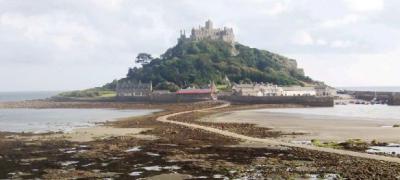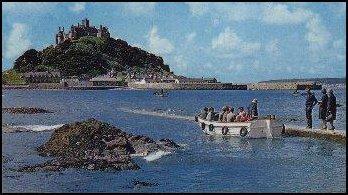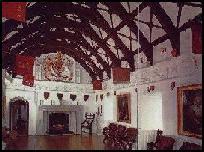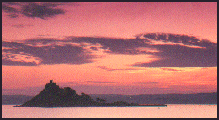


The jewel in Cornwall's crown
Marazion, Near Penzance, TR17 0HT
Tel: (01736) 887822
Email: enquiries@stmichaelsmount.co.uk
Web: www.nationaltrust.org.uk/visit/cornwall/st-michaels-mount
Web: www.visitcornwall.com/things-to-do/family-attractions/st-michael-s-mount
Web: www.stmichaelsmount.co.uk
St. Michaels Mount Parish Council
Dominating Mounts Bay is St. Michael's Mount, which rises majestically almost 230 feet from the sea. This magical island has a church, a medieval castle (home of the St. Aubyn family for over 300 years), an exotic garden clinging to the steep flanks, and an ancient harbour where you will find shops, restaurants and an audio-visual presentation on the history of the Mount. Situated approximately 500 yards offshore the Mount is reached by small ferry boats which ply between Marazion and the Mount's harbour at high tide or by foot along the causeway at low tide. The population of this parish in 2011 was 35.

The Mount is dedicated to the Archangel St. Michael, who according to Cornish legend, appeared to some fishermen in the year 495 on the Western side of the mount.
St. Michael's Mount was widely known as a port by Prehistoric traders and was probably the island of 'Ictis' from which Cornish tin was exported to the Greek trading communities around the fourth century B.C. In 1099 the Mount was located six miles from the sea, enclosed in a thick wood, until a sudden rise in the sea level mad it an island.
The mount is situated right on the path of two ley-lines. One coming right down through Cornwall from Glastonbury and beyond, passing through The Hurlers, Helman Tor and Carn Brea. The other originating in Israel and passing through Greece, Italy and France, crosses Mont Saint Michel and St. Michael's Mount before ending at Skelling in Ireland.
Originally the site of a Benedictine chapel established by Edward the Confessor, the castle is situated on top of a rocky island and dates from the 14th century. It contains an armoury, a rococo Gothic drawing room and a 14th century church.

Edward the Confessor granted the mount to the Benedictine monks from Mont St. Michel in France, and by 1135 they had built a priory on the summit of the mount. They also constructed a harbour and causeway. Henry V granted it to the Abbey of Syon in Twickenham. From the 12th century it was the site of a number of military sieges, as well as a place of pilgrimage.
Henry Pomeroy captured The Mount on behalf of Prince John, in the reign of Richard I. John de Vere, 13th Earl of Oxford, seized it and held it during a siege of 23 weeks against 6,000 of Edward IV's troops in 1473. Perkin Warbeck occupied the Mount in 1497. Sir Humphrey Arundell, governor of St. Michael's Mount, led the rebellion of 1549.
Then Henry VIII sequestered it on the dissolution of the monasteries. At that point in its history it became a fortress. It was threatened, but not actually attacked during the Spanish raid on Mounts Bay. During the reign of Queen Elizabeth it was given to Robert Cecil, Earl of Salisbury, by whose son it was sold to Sir Francis Basset in 1640.

Basset also repaired and equipped St. Michael's Mount, at great personal expense. This included the construction of new gun platforms and a new gate, provision of fourteen new guns at £10 each, twenty one new pairs of wheels and gun carriages, as well as powder and match, muskets, and bullets. Between 1642 and 1644 Basset paid twelve men and a gunner at the Mount and, in 1645, when the garrison increased to fifty soldiers by the King's command, Basset met the additional cost from his own resources.
During the Civil War, Sir Arthur Basset, brother of Sir Francis, held the Mount against the parliament until July 1646. The commander of the Parliamentarian forces that captured the mount during the Civil War was Colonel John St. Aubyn. He purchased it from the state at the end of the Civil War in 1659. It is one of his descendants, Lord St. Levan, who still lives there.
Sir John Aubyn, the third Baronet, re-built the harbour in 1727. By 1811 the island exported pilchards, tin and copper ore. Iron, timber, corn and salt were bought in. The pier was extended in 1821 and the population peaked in the same year, when the island had 221 people. The village went into decline following major improvements to nearby Penzance harbour and the extension of the railway to Penzance in 1852, and many of the houses and buildings were demolished. Many of the men in the village were fishermen, others were sail-makers and pilots. Some of the women worked in the island laundry. During the 1870's the substantial south-east wing was added.
In 1755 there was a tsunami, caused by an earthquake in Lisbon. The tsunami waves hit St. Michael's Mount, with the height of the sea water rising and falling six feet many times over five hours. This caused a loss of life and of property at the base of the Mount.
Queen Victoria visited the island in September 1846, along with Prince Albert and their children. They had sailed their in their yacht and Queen Victoria's footprint is preserved at the top of the harbour steps.
In the Mount's hey day as a busy tin and copper port, there were 53 houses, four streets, three schools & three public houses on the island, the last one, the St. Aubyn Arms, closing in 1902.
A single line railway was constructed in 1900, climbing from the harbour to the summit of 650 feet, which was used to carry luggage up to the house.
In various rooms of the castle, there are paintings and portraits by artists such as Gainsborough, Kneller, Hudson and the Cornish artist John Opie. The Chevy Chase Room, which was formerly the monks' refectory, is decorated with a 17th century frieze around the walls depicting hunting scenes. The 18th century Blue Drawing Rooms are decorated with superb Strawberry Hill Gothic plaster work and contain elegant Chippendale furniture. The Map Room and Museum Room contain original maps, 18th century clothes and family silver. Also displayed is an outstanding collection of weapons, bought back by the family in different wars.
The grandeur and wealth of history of St. Michael's Mount, with its fairy tale castle, make it a unique attraction in Britain. An island at high tide, from the great flood in 1099, the Mount is now a treasure of the National Trust, given to them by Lord St. Levan in 1954. The population of the mount at the 2011 census was 35.
1967 the Queen Mother visited St. Michael's Mount. She arrived by sea, using a small pinnace to travel between The Royal Yacht Britannia anchored off-shore and the harbour.
In 2004, James and Mary St. Aubyn moved to the castle with their four children. They in their turn became Lord and Lady St. Levan when the previous Lord, James's uncle, died in 2013. As of 2016 his descendants, the Lords St. Levan, remain seated at St. Michael's Mount.
1250 Frà Richard le Scrope,
1262 Frà Ralph de Vieilles,
1266 Frà Ralph de Carteret,
1275 Frà Richard de Perrers, collated by Bishop Bronescombe
1283 Frà Geoffrey de Gernon,
1316 Frà Peter de Carewe, Prior during Bishop Grandisson's visitation,
1342 Frà Nicholas d'Isabelle,
1349 Frà John Hardy, until indictment at Launceston 1354
1362 Frà John de Voland,
1385 Frà Richard de Harepath, his official prioral brass seal survives
1412 Dom. William Lambert, Prior
1537 Mgr. Richard Arscott, Archpriest
1539 Dissolution of Syon Monastery; St. Michael's Mount reverted to the Crown
1611 Royal grant of the St. Michael's Mount to Robert, Earl of Salisbury
1640 Fee conveyed to William, Earl of Salisbury by Sir Francis Bassett
1659 Colonel John St. Aubyn
Easily visible just off the coast at Marazion.
St. Michael’s Mount Swim - Early August.
St. Aubyn Arms - closed 1906
Opening TimesApril - October Admission Charged |
Cornish Castles Marazion National Trust Properties Tremenheere Sculpture Gardens Penzance
Cornish Celtic Way The Penwith Peninsula